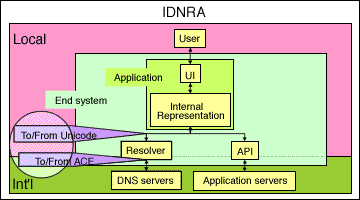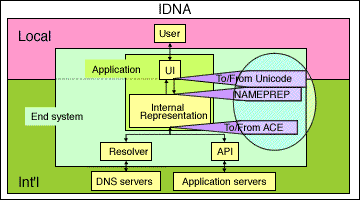3 Special Feature Japanese Page
3-3 The mDNkit
3-3-1 Purpose of the mDNkit
mDNkit stands for "Multilingual Domain Name evaluation Kit" and is a JPNIC project that began in April 2000 with the following aims:
- to evaluate technologies related to multilingual domain names
- to promote standardization of multilingual domain names
- to contribute technologically to the Internet community
JPNIC released the mDNkit as a free software program with a very lenient set of licensing rules, so that anyone could use it free of charge and without restrictions.
JPNIC released the first beta versionm of the DNkit on July 13, 2000, and official version 1.0 on October 18, 2000. Thereafter, we have released updated versions whenever necessary to increase its functionality and/or to correct bugs. The most recent version of the mDNkit and the data on its release history can be downloaded from the following URL:
http://www.nic.ad.jp/jp/research/idn/index.html#mdnkit
In addition, the most recent version of BIND[1], the most widely-used Internet DNS server, now includes the mDNkit as one of its contribution software programs.
3-3-2 mDNkit Development Policy
To standardize Internet protocols, it is necessary that there be more than one example of implementation for each suit of protocols proposed, and each must have interoperability. And to diffuse the standard, it is important that users should be able to obtain and use the reference suit with no charge.
The development policy of the mDNkit is to enable anybody to technologically evaluate multilingual domain names easily, by promptly implementing a leading system which has been proposed in IETF[2]'s IDN-WG[3] and by distributing this program as a free software.
Furthermore, in order to appropriately evaluate the technology, it is necessary that existing application programs can support the multilingual domain name. Therefore, the development policy also includes the distribution of libraries and APIs to add name resolution function for multilingual domain names for Windows and UNIX application programs.
3-3-3 Current Specifications
With the current specifications, the mDNkit resolves multilingual domain names at the resolver library or vicinity, using a method that is based on a concept called "IDNRA[4]." Figure 1-1 shows the concept behind IDNRA.

mDNkit version 1 (mDNkit-1.x) specifications are based on the IDNRA concept.
3-3-4 Future Specifications
The IDNRA concept was influential at the time that development of the mDNkit began, but it is not compatible with most application protocols, such as mailers and Web browsers, that make reference to domain names. Through subsequent IDN-WG discussions, therefore, a concept called "IDNA[5]" has become the prevailing way of thinking.
Accordingly, JPNIC is now in the middle of developing a new version 2.x of the mDNkit which will be compatible with IDNA. Figure 1-2 below shows the IDNA concept.

mDNkit version 2.0 will be released in late March or early April of this year.
| [1] |
Berkeley Internet Name Domain http://www.isc.org/products/BIND/ |
| [2] |
Internet Engineering Task Force http://www.ietf.org/ |
| [3] |
Internationalized Domain Name Working Group http://www.i-d-n.net/ |
| [4] |
Internationalized Host Names Using Resolvers and
Applications http://www.i-d-n.net/draft/draft-ietf-idn-idnra-00.txt |
| [5] |
Internationalizing Host Names In Applications http://www.i-d-n.net/draft/draft-ietf-idn-idna-01.txt |




